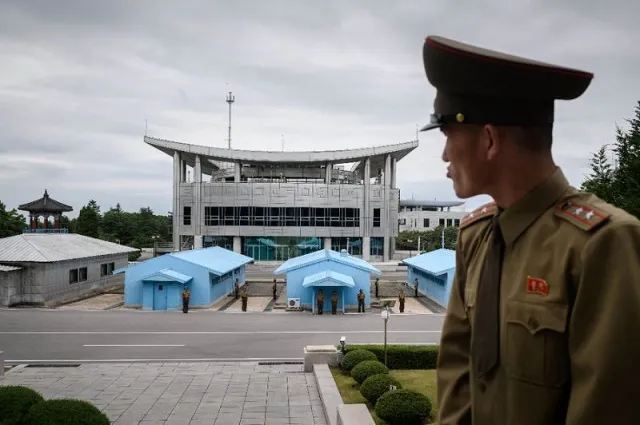Khu vực An ninh chung (JSA), còn được biết với tên làng đình chiến Bàn Môn Điếm (Panmunjom), trong lịch sử là điểm nóng và vị trí chiến lược về ngoại giao giữa Hàn Quốc và Triều Tiên kể từ khi chia cắt vào năm 1953. Đây cũng là khu duy nhất của DMZ mà binh lính Hàn – Triều đứng mặt đối mặt.

Binh lính tại khu Bàn Môn Điếm. Ảnh: AFP
Bắt đầu từ ngày 26/10, tất cả binh lính tại đây sẽ được giải giáp vũ khí, là một phần trong kế hoạch nối lại quan hệ liên Triều, người phát ngôn Choi Hyun-soo của Hàn Quốc cho hay.
Một khi loại trừ hết quân và vũ khí tại đây, Khu vực An ninh chung sẽ được bố trí 35 nhân viên không vũ trang cho cả hai phía và du khách tham quan cũng được phép di chuyển tự do vào khu vực này, theo một hiệp ước ký kết bởi hai nước hồi tháng trước.
Hiệp ước này là một phần trong số những động thái nỗ lực giảm căng thẳng quân sự tại biên giới giữa Hàn Quốc và Triều Tiên, sau cuộc gặp giữa Tổng thống Moon Jae-in và lãnh đạo Kim Jong Un.
Cả hai bên đã hoàn tất việc tháo dỡ bom mìn còn sót lại tại khu JSA hồi tuần trước, đạt một phần của thỏa thuận.
Hội nghị hồi tháng Chín vừa rồi là hội nghị thứ 3 trong năm giữa lãnh đạo hai nước, đánh dấy một bước của việc nối lại tình hữu nghị trên báo đảo Triều Tiên.
Hai miền Triều Tiên và đại diện Bộ Tư lệnh Liên Hiệp Quốc sau đó sẽ tiến hành xác minh chung.
Tuy nhiên, theo lời từ tướng Vincent Brooks, người đứng đầu Bộ Tư lệnh Liên Hiệp Quốc cũng là Tư lệnh quân đội Mỹ tại Hàn Quốc, ông nhận thấy có một “mức độ rủi ro hợp lý” trong kế hoạch tháo dỡ các trạm gác tại khu vực DMZ của Hàn Quốc.
Koreas remove guns from Cold War truce village
(AFP) - The two Koreas were removing the last remaining firearms and guard posts on Thursday from a Cold War era truce village where armed soldiers have stared each other down for decades, Seoul's defence ministry said.
The Joint Security Area -- also known as the truce village of Panmunjom -- has historically been both a flashpoint and a key location for diplomacy between the two Koreas ever since their split in 1953.
It is the only spot along the tense, 250-kilometre (155-mile) frontier where soldiers from North Korea and the US-led United Nations Command stand face to face.
By Friday, all guards will be disarmed, ministry spokeswoman Choi Hyun-soo said, part of a recent diplomatic thaw between the two foes that has gathered pace.
"I am aware that it is going according to plan," Choi told reporters.
Panmunjom was where the armistice that ended the bitter Korean War was signed.
It was a designated neutral zone until the "axe murder incident" in 1976, when North Korean soldiers attacked a work party trying to chop down a tree inside the Demilitarized Zone (DMZ), leaving two US army officers dead.
Once demilitarised, the JSA will be guarded by 35 unarmed personnel from each side and "freedom of movement" will be allowed for visitors and tourists, according to a military pact signed between the two Koreas last month.
South and North Korea -- which are technically still at war -- agreed to take measures to ease military tensions on their border at a meeting in Pyongyang last month between President Moon Jae-in and Kim Jong Un.
The two sides finished removing landmines at the JSA -- which has been increasingly used for talks between the two Koreas -- last week as part of the deal.
The September summit was the third this year between the leaders, as a remarkable rapprochement takes hold on the peninsula. Moon has advocated engagement with the isolated North to nudge it toward denuclearisation.
The two Koreas and the UN Command, which is included as it retains jurisdiction over the southern half of the JSA, will conduct a joint verification until Saturday.
The UNC chief, US general Vincent Brooks, told reporters in August that as UN commander he supported initiatives that could reduce military tensions.
But he added that as commander of the combined US-South Korean forces -- one of his other roles -- he felt there was a "reasonable degree of risk" in Seoul's plans to dismantle guard posts near the DMZ.

